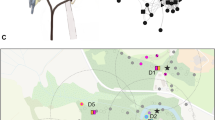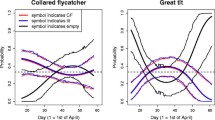Abstract
Recent work increasingly reveals the importance of social information in individual dispersal decisions, population dynamics and conservation. Much of the knowledge gained to date comes from studies on short-lived and/or densely breeding species. In contrast, our understanding of the processes involved in nest-site selection for long-lived, solitary breeding species is insufficient. We increased nest-site availability by nest-box supplementation over a 5-year period in a population of a long-lived, solitary, secondary-cavity nesting bird, the European roller Coracias garrulus, breeding in natural cavities and human constructions. We tested the nest limitation and the inadvertent conspecific social information hypothesis in order to study the dynamics and mechanisms of abandonment of previously used nests and the colonisation of new ones. Our data lend support to the nest-limitation hypothesis both in terms of quantity—population and the size of breeding clusters increased, and suitability—the majority of pairs used and re-occupied nest-boxes. Nevertheless, the use of natural cavities did not decrease after 5 years. At the between-patch scale, rollers were revealed to colonise nest-boxes based on conspecific social attraction, namely distance to the nearest neighbour in the same season. Despite the unpredictability of patch productivity, at the within-patch scale, the selection of previously unoccupied cavities was consistent with the performance-based conspecific attraction hypothesis. Philopatry could account for the repeated use of cavities, because nests that were used for two successive years were more likely to also be reused in the subsequent season.




Similar content being viewed by others
References
Ahlering MA, Faaborg J (2006) Avian habitat management meets conspecific attraction: if you build it, will they come? Auk 123:301–312
Avilés JM, Sánchez A (2000) Avian responses to nest-box installation in steppes of the south-west of the Iberian Peninsula (Extremadura). Avocetta 24:51–54
BirdLife International (2009) Species factsheet: Coracias garrulus. http://www.birdlife.org (accessed 05/04/2010)
Brown CR, Brown MB, Danchin E (2000) Breeding habitat selection in cliff swallows: the effect of conspecific reproductive success on colony choice. J Anim Ecol 69:133–142
Butler S (2001) Nest-site selection of the European Roller (Coracias garrulus) in the Vallée des Baux de Provence. MSc report
Casas-Crivillé A, Valera F (2005) The European Bee-eater (Merops apiaster) as an ecosystem engineer in arid environments. J Arid Environ 60:227–238
Coolen I, van Bergen Y, Day LR, Laland KN (2003) Species difference in adaptive use of public information in sticklebacks. Proc R Soc Lond B 270:2413–2419
Cramp S (1998) The complete birds of the Western Palearctic on CD-ROM. Oxford University Press, Oxford
Danchin E, Wagner RH (1997) The evolution of coloniality: the emergence of new perspectives. Trends Ecol Evol 12:342–347
Danchin E, Boulinier T, Massot M (1998) Conspecific reproductive success and breeding habitat selection: implications for the study of coloniality. Ecology 79:2415–2428
Doligez B, Danchin E, Clobert J (2002) Public information and breeding habitat selection in a wild bird population. Science 297:1168–1170
Doligez B, Cadet C, Danchin E, Boulinier T (2003) When to use public information for breeding habitat selection? The role of environmental predictability and density dependence. Anim Behav 66:973–988
Fletcher RJ (2006) Emergent properties of conspecific attraction in fragmented landscapes. Am Nat 168:207–219
Forsman JT, Hjernquist MB, Taipale J, Gustaffson L (2008) Competitor density cues for habitat quality facilitating habitat selection and investment decisions. Behav Ecol 19:539–545
Franco AMA, Marques JT, Sutherland WJ (2005) Is nest-site availability limiting lesser Kestrel populations? A multiple scale approach. Ibis 147:657–666
Gauthier G, Smith JNM (1987) Territorial behaviour, nest-site availability, and breeding density in buffleheads. J Anim Ecol 56:171–184
Hahn BA, Silverman ED (2006) Social cues facilitate habitat selection: American redstarts establish breeding territories in response to song. Biol Lett 2:334–337
Holt RD (2007) IJEE soapbox: the unraveling of nature’s information webs: the next depressing frontier in conservation? Isr J Ecol Evol 53:229–236
Holt RF, Martin K (1997) Landscape modification and patch selection: the demography of two secondary cavity nesters colonizing clearcuts. Auk 114:443–455
Littell RC, Milliken GA, Stroup WW, Wolfinger RD, Schabenberger O (2006) SAS for mixed models, 2nd edn. SAS Institute, Cary NC
Manrique J (1996) Corología y ecogeografía de las aves nidificantes en la provincia de Almería (SE ibérico). PhD dissertation, Universidad de Granada, Granada
Martin TE (1995) Avian life-history evolution in relation to nest sites, nest predation, and food. Ecol Mon 65:101–127
Martin K, Aitken KEH, Wiebe KL (2004) Nest sites and nest webs for cavity-nesting communities in interior British Columbia, Canada: nest characteristics and niche partitioning. Condor 106:5–19
Newton I (1998) Population limitation in birds. Academic, London
Ophir AG, Galef BG (2004) Sexual experience can affect use of public information in mate choice. Anim Behav 68:1221–1227
Parejo D, Danchin E, Avilés JM (2005) The heterospecific habitat copying hypothesis: can competitors indicate habitat quality? Behav Ecol 16:96–105
Parejo D, Oro D, Danchin E (2006) Testing habitat copying in breeding habitat selection in a species adapted to variable environments. Ibis 148:146–154
Petty SJ, Shaw G, Anderson DIK (1994) Value of nest boxes for population studies and conservation of owls in coniferous forests in Britain. J Raptor Res 28:134–142
Pöysä H, Pöysä S (2002) Nest-site limitation and density dependence of reproductive output in the common goldeneye Bucephala clangula: implications for the management of cavity-nesting birds. J Appl Ecol 39:502–510
Quinn GP, Keough MJ (2007) Experimental design and data analysis for biologists. Cambridge University Press, Cambridge
Reed J (1999) The role of behavior in recent avian extinctions and endangerments. Conserv Biol 13:232–241
Reed JM, Dobson AP (1993) Behavioural constraints and conservation biology: conspecifics attraction and recruitment. Trends Ecol Evol 8:253–256
Roy C, Eadie JM, Schauber EM, Odell NS, Berg EC, Moore T (2009) Public information and conspecific nest parasitism in wood ducks: does nest density influence quality of information? Anim Behav 77:1367–1373
Schmidt KA, Dall SRX, van Gils JA (2010) The ecology of information: an overview on the ecological significance of making informed decisions. Oikos 11:304–316
Smiddy P, O’Halloran J (2004) The ecology of river bridges: their use by birds and mammals. In: Davenport J, Davenport JL (eds) The effects of human transport on ecosystems: cars and planes, boats and trains. Royal Irish Academy, Dublin, pp 83–97
Stamps JA (1988) Conspecific attraction and aggregattion in territorial species. Am Nat 131:329–347
Switzer PV (1997) Past reproductive success affects future habitat selection. Behav Ecol Sociobiol 40:307–312
Valone TJ, Brown JS (1989) Measuring patch assessment abilities of desert granivores. Ecology 70:1800–1810
Ward MP, Schlossberg S (2004) Conspecific attraction and the conservation of territorial songbirds. Conserv Biol 18:519–525
Whiting MJ, Greeff JM (1999) Use of heterospecific cues by the lizard Platysaurus broadleyi for food location. Behav Ecol Sociobiol 45:420–423
Wiens JA (1984) Resource systems, populations, and communities. In: Price PW, Slobodchikoff CN, Gaud WS (eds) A new ecology. Novel approaches to interactive systems. Wiley, New York, pp 397–436
Acknowledgments
We thank R.H. Wagner, J.T. Seppänen, M. Orell and an anonymous referee for fruitful comments and suggestions, and J. Manrique for sharing unpublished information with us. M.A. Calero-Torralbo helped with field-work. During the elaboration of this paper the authors received financial support from the Spanish Ministry of Science and Innovation (SB2003-0333), the SAS-CSIC bilateral program (Ref. 2007SK0006), and the Programa de Incentivos de Carácter Científico y Técnico de la Junta de Andalucía (2/2008). F.V. also received financial support from the Spanish Ministry of Science and Innovation (CGL2008-00562) and the European Regional Development Fund.
Author information
Authors and Affiliations
Corresponding author
Additional information
Communicated by Markku Orell.
Rights and permissions
About this article
Cite this article
Václav, R., Valera, F. & Martínez, T. Social information in nest colonisation and occupancy in a long-lived, solitary breeding bird. Oecologia 165, 617–627 (2011). https://doi.org/10.1007/s00442-010-1848-1
Received:
Accepted:
Published:
Issue Date:
DOI: https://doi.org/10.1007/s00442-010-1848-1




